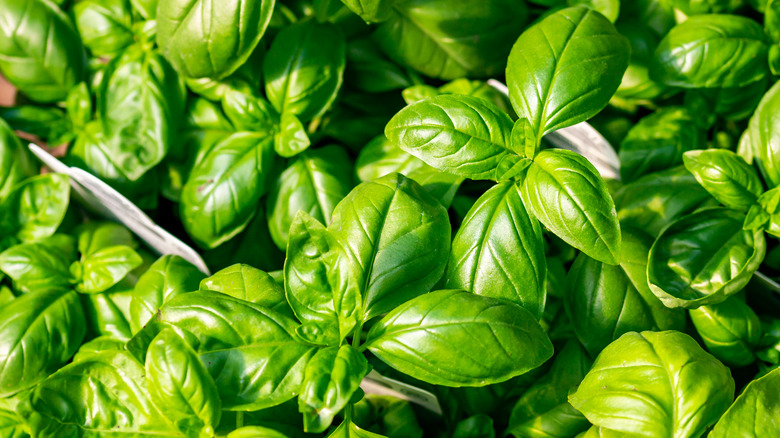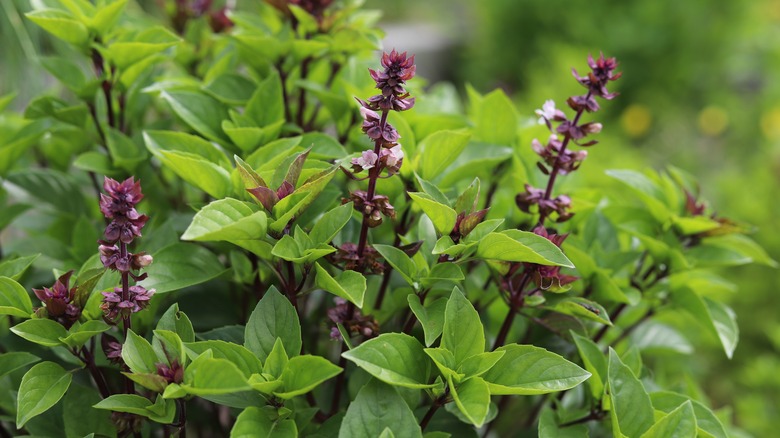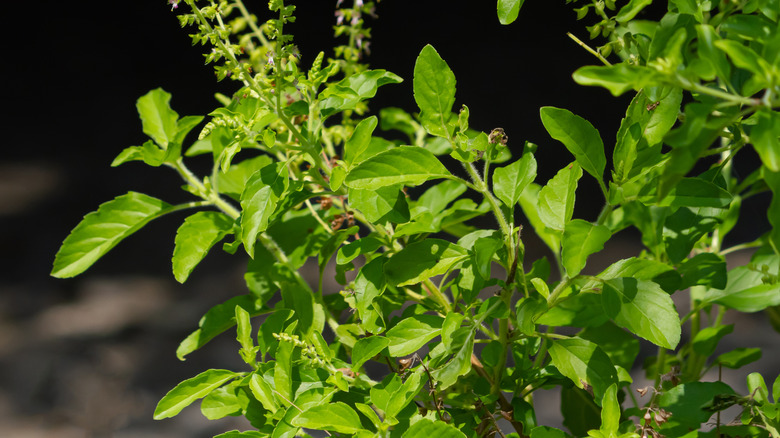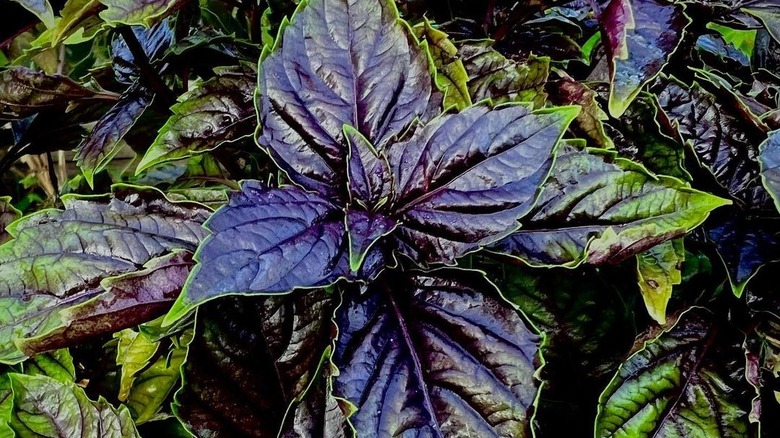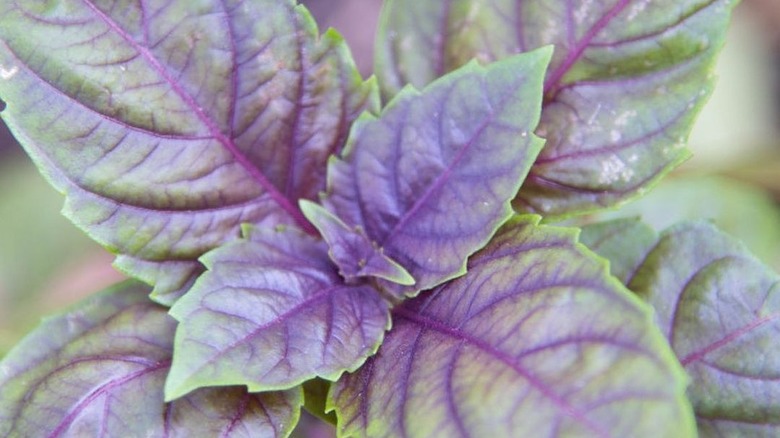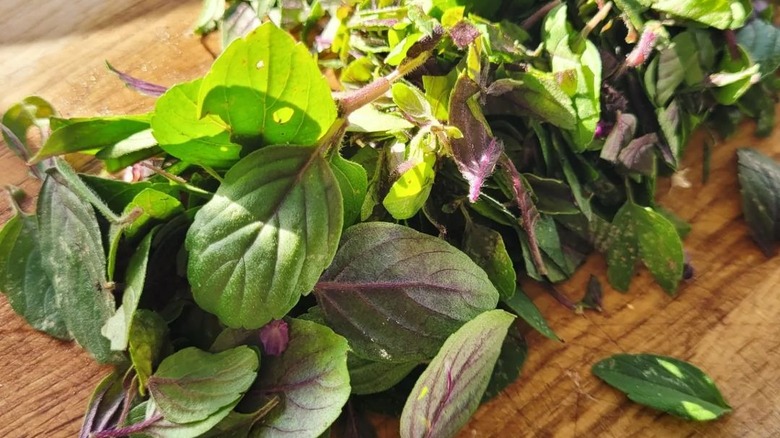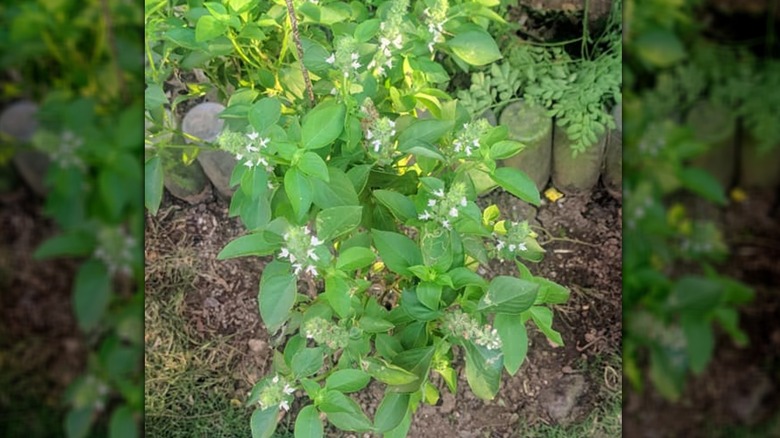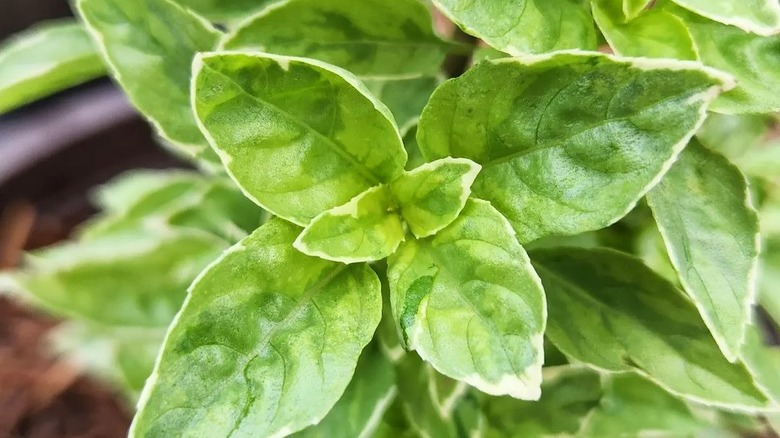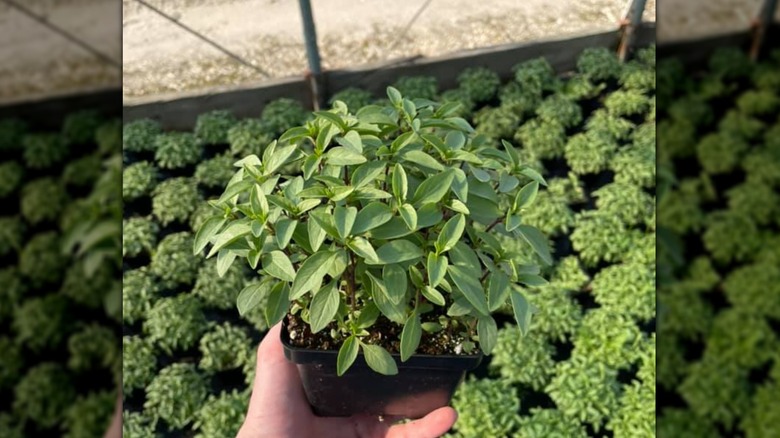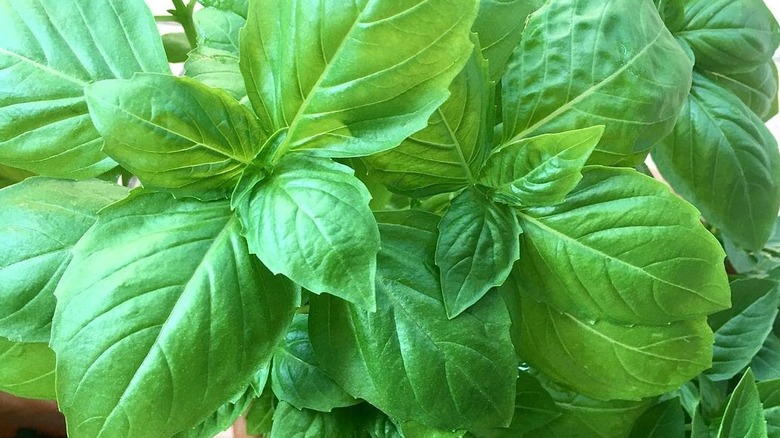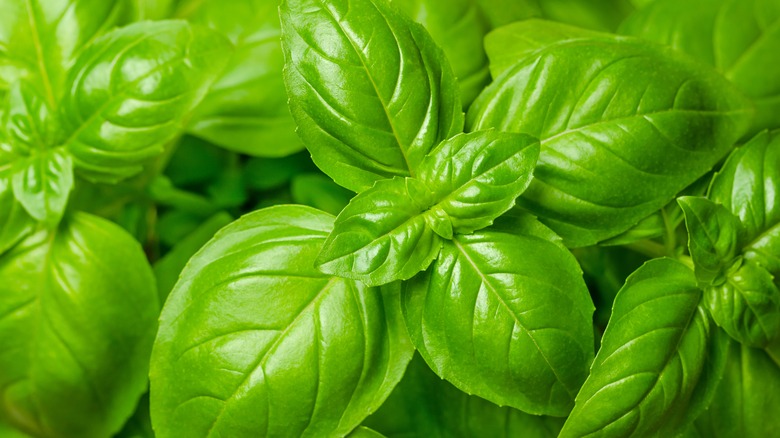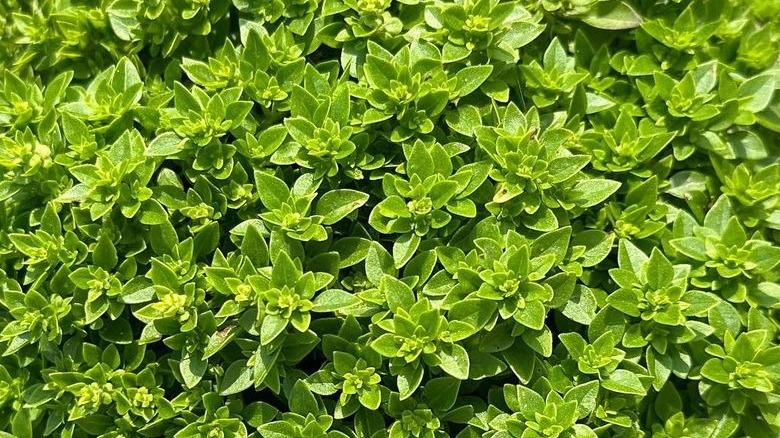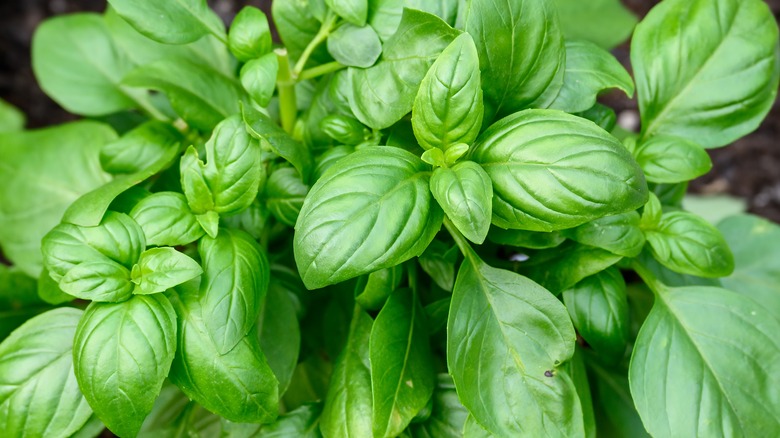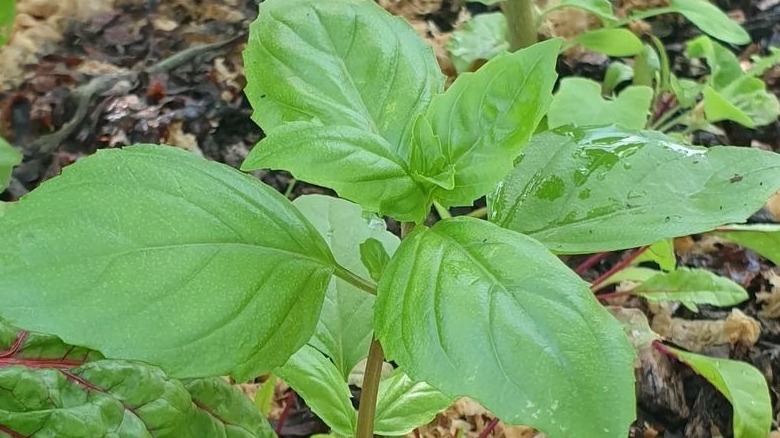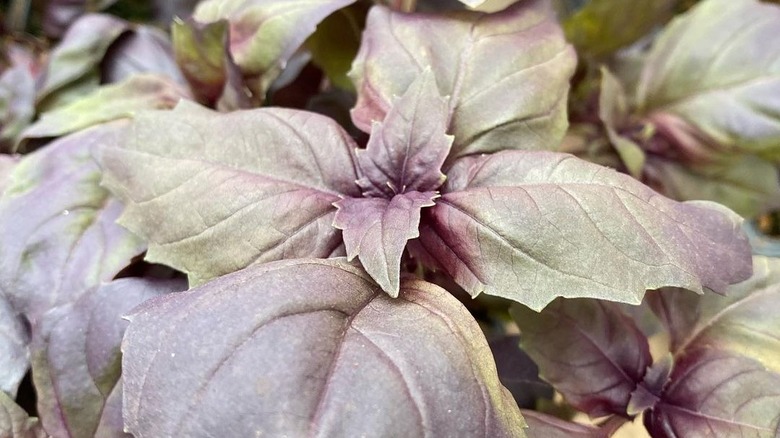15 Types Of Basil And How To Use Them
Refreshingly earthy, nutrient-dense, and super easy to grow at home, basil is one of the best herbs around. Along with oregano, thyme, and rosemary, it's part of the mint family. Basil was first cultivated over 5,000 years ago in either China, India, or Africa — the exact origin is unknown, although the herb is native to these areas. Herb Society says that basil is considered a sacred herb in Hinduism and was used in burial ceremonies in India and Egypt. This herb's mythic powers take another form in Rome, where the fragrance is considered an aphrodisiac. During the Middle Ages, people believed basil had to power to create scorpions!
Thankfully, although basil has exploded in popularity over the years, the world's scorpion population hasn't. Today there are over 60 known varieties of basil, and the ancient herb is enjoyed worldwide. Basil tends to carry both sweet and savory notes that include similarities to mint, anise, lemon, and pepper. The taste can vary between types, though; for example, lemon basil has a zesty citrusy taste, whereas mint basil carries a fresh and minty one. There's no wonder basil is an awesome ingredient in cooking!
From classic Italian pasta dishes to traditional Southeast Asian stir-fries, basil's herbaceous touch brightens recipes up. That said, with so many varieties of basil, it begs the question, "Which types can be used in cooking?" Well, worry not! We've put together a list of 15 types of basil and how to use them in the kitchen.
Thai basil
One of the most popular varieties of basil is Thai. It's an earthy and sweet-scented basil that's slightly spicy and licorice-like. Despite its saccharine notes, it's totally distinct from the similar-looking and aptly-named Sweet basil. Thai basil originates from Southeast Asia and, according to Specialty Produce, is one of three groupings of basil: Thai, sweet, and holy basil. Thai basil can withstand high temperatures, which makes it great for cooking. In particular, Siam Queen is the most popular type of Thai basil and can be identified by its larger leaves and noticeable black licorice flavor.
Thai basil's distinctive taste is traditionally used in Southeast Asia and, of course, Thai cuisine. Rice and noodle-based dishes, curry sauces, spring rolls, and more feature its aromatic flare. For example, one of the most popular Thai dishes that uses basil is gai pad nam prik pao, or chicken with roasted chili paste and basil. It's a spicy and full-flavored meal balanced by basil's herby notes. This wonder herb is also popular outside of Southeast Asia and is a staple ingredient in Italian cuisine.
Tulsi Holy basil
Another popular variety of this sacred herb is called Tulsi Holy basil. You've probably seen it in tea at your local grocery store. It's a staple ingredient in Ayurvedic medicine, an ancient holistic system that originated in India over 3,000 years ago. There are four members of the Tulsi family: Krishna, Rama, Kapoor, and Vana Tulsi. Each carries a distinct color, aroma, and flavor profile. Tulsi basil can be taken medicinally and used in cooking.
As mentioned, tea is a popular way of using Tulsi basil. Tulsi herbal tea has a mild herbaceous taste with an astringent effect that leaves the tongue somewhat dry. Known for its health-supporting benefits, WebMD says that one-half cup of this magical herb nearly contains your daily recommended intake of vitamin K, a fat-soluble micronutrient that improves heart and bone health. That's only one of many benefits it has to offer.
Like other basils, fresh and dried Tulsi can also be used in cooking. It's a mainstay in Thai cuisine, where locals enjoy its earthy touch in dishes like the famous gai pad grapow (or spicy Thai basil chicken) and phat kraphao, a type of stir-fry. It carries a piquant and pungent flavor that intensifies when cooked. Like any herb, Tulsi basil is best enjoyed when fresh and aromatic.
Dark Opal basil
This basil looks nothing like the common variety. Rather than a vibrant green, like its name, Dark Opal basil is a purple-ish color similar to an eggplant, with variegated hues of burgundy and green. The leaves are smooth, medium-sized, and oval-shaped. Dark Opal basil has a spicy, clove-like aroma and tastes sweet, savory, and earthy. Its flavor profile comprises anise, ginger, cinnamon, clove, and mint. Its strong scent can even repel some insects. Easy to grow in containers, it can be picked and eaten straight from the stem.
When it comes to cooking, Dark Opal basil's mildly sweet and vegetal flavor pairs great with curries, soups, and stews. Unsurprisingly, it's also wonderful in pesto. Along with delicious recipes, Dark Opal brews up a tasty anise-like tea. It works as a substitute for green basil varieties, too. You can enjoy it with tomatoes, strawberries, watermelon, and blackberries. It can usually be found year-round at Walmarts and gardening stores — you can even order it on Instacart.
Purple Ruffles basil
Coming from the same family as the Dark Opal variety, Purple Ruffles basil is another type we recommend giving a try. It was created in 1980 by breeder and former director of research at W. Atlee Burpee and Company, Ted Torrey, and officially recognized as a novel variety of basil by the United States in 1982 (via Specialty Produce). Purple Ruffles basil is known for having large, ruffle-textured leaves, which are aesthetically pleasing and commonly used as ornaments. This herby gift isn't only for looking at, though; it's an equally awesome ingredient to use in cooking.
Purple Ruffles are a great substitute for Genovese or other green-hued sweet basils that have similar characteristics. You can expect a sweet and peppery flavor that can be used as a garnish or for adding freshness to recipes. Use it to take salads, soups, pastas, and more to new heights. The leaves retain their purple color even when cooked, giving dishes a touch of vibrancy. In addition to cooking, Purple Ruffles go perfectly with almonds, walnuts, and pine nuts, which are used in pesto.
African Blue basil
Discovered in the 1980s, African Blue is a special variety of basil that's a hybrid of Dark Opal and Camphor, which is native to East Africa. Its leaves have an elliptical shape with a slightly tapered tip. They're flat and broad, have serrated edges, and are smooth textured. Although it starts purple, as African Blue matures, it develops a more purple-greenish hue.
Regarding consistency, this special herb is crisp and succulent, carrying notes of wood, musk, cloves, and mint. Pretty lavender flowers will bloom from the plant as it continues to mature. Aesthetics aside, the best part about African Blue basil is cooking with it. It works best when consumed fresh or used as a garnish. As is common amongst basil varieties, you can also use it to make pesto.
African Blue is harder to find than other basil types. Garden supply stores are usually the best places to search for it. If you're lucky enough to get your hands on a bunch, we definitely recommend flexing your culinary imagination. Mix it into herbaceous sauces like chimichurri, salad dressing, or dips. Along with savory condiments, it can also elevate desserts and cocktails. Wherever the culinary winds blow, just make sure not to overuse it, as the leaves are quite strong.
Lemon basil
Put a "sprig" in your step with Lemon basil, a citrusy-scented variety native to India. It's an ingredient typically found in Southeast Asian cuisine, paired with meat dishes, vegetables like zucchini and asparagus, soups, and so much more. Whip it out when you're looking to add a little herbal, sweet, and tangy pizazz to your recipe. Although it's excellent for cooking, Lemon basil is at its best when used to finish dishes. The delicate citrus and anise notes shine brightest when fresh and robust. That means timing is everything, so use it as soon as the food is plated.
Unlike Purple Ruffles and Thai, Lemon basil's leaves typically range from small to medium and are oval-shaped with a pointy tip. Fresh lemon basil leaves are a lively green and smooth with a sweet, citrusy aroma. There is a caveat, though — buying Lemon basil in the U.S. is harder than Sweet basil because it's rare. You can usually only find it fresh at farmer's markets and Asian grocery stores.
Pesto Perpetuo basil
After you discover this next basil variety, you'll be craving the classic sauce it's named after. Pesto Perpetuo basil doesn't only have a super cool name, which means "perpetual pesto," but it's a fairly recent discovery as well. Per the Missouri Botanical Garden, it's a genetic mutation from a Greek columnar plant called Lesbos, that was discovered in 2004. The name Lesbos comes from an island in Greece. Pesto Perpetuo is beloved for its ornamental qualities and aromatic charm.
Unlike Sweet and Genovese basil, Pesto Perpetuo has lighter green leaves with white-striped edges. Lemony-fresh and distinctly basil, we recommend trying it out in the kitchen. The leaves are garnish-ready and can be stored in the freezer for later enjoyment. Making pesto with this particular basil variety is an obvious must-try, too. Herbaceous with a Spring-like lightness, don't blame us if you find yourself using it on everything. Just make sure to wait until the food is hot and ready before blending it in. Trust us, cooking the flavor away would be a huge mistake with pesto.
Spicy Globe basil
Related to Sweet basil, Spicy Globe likely originates from Greece (via Gardener's Path). True to its name, it carries a peppery flavor and grows into a globe-shape. If you like it hot and herby, this special basil is the way to go. Whereas some basil types can grow as high as 24 inches, Spicy Globe is a compact plant that only reaches six to 12 inches. That makes it ideal for growing indoors, especially in winter when temperatures are too harsh for herbs.
The kitchen is where Spicy Globe shines, though. The tiny leaves release basil-y goodness without having to be cut or squeezed. It's a fresh and spicy symphony that elevates tomato-based pastas, invigorates sauces, and enhances meats. The heat level is also subtle, not overwhelming, like arugula or radishes. Try it in a spicy basil Caprese salad, or impress the palate with succulent herb and citrus chicken. You should be able to find it at farmer's markets and larger-chain grocery stores.
Italian Large Leaf basil (Napoletano)
Originating from the boot-shaped country of Italy, this variety of basil is beloved for its distinct taste. Out of the 60 varieties that exist, the Napoletano variety has the largest leaves. They're light green, ruffled, spear-shaped, and carry a subtle accent of spicy anise. The leaves aren't only large, they're packed with nutrients like vitamins K, A, and C, along with essential minerals.
If you enjoy the taste of basil, you'll love eating Italian Large Leaf raw. The leaves can even be used as refreshing appetizer wraps, thanks to their size. Pair with mozzarella and tomatoes for a Mediterranean classic, or wrap your favorite protein for a quick and easy bite. It can be used in any recipe as a substitute for sweet basil. Whether fresh or dried, infuse everything from dressings and sauces to soups and pastas. Remember to wait until the spaghetti is cooked before adding basil.
Genovese basil
In Italy, Genovese basil reigns supreme. A cultivar of sweet basil, the Romans brought it to Italy and planted it in a region known as Liguria. There, the microclimate was ideal for growing. They believed it to have healing powers and even invented a precursor to pesto called moretum, a Genovese basil sauce made with olive oil, cheese, and herbs. Modern Genovese pesto as we know it wasn't created until the early 1800s in Genoa, Italy — hence the name. Clearly, those industrious Romans were on to something, as Genovese basil is now popular worldwide.
Taste-wise, Genovese basil is minty and citrusy, with subtle hints of clove and pepper. The most popular way to bring out its earthy magic is, of course, pesto alla Genovese. The classic sauce takes what the Romans started and adds crushed garlic, European pine nuts, and coarse salt. Such culinary inventiveness deserves a slow clap. Another popular traditional dish is pesto alla trapanese, which comes from the Italian province of Trapani and includes the same ingredients as pesto, with the addition of Pachino cherry tomatoes and substitution of pine nuts for almonds.
Greek basil
Basil is considered a sacred herb in Greece and has a strong connection to Christianity. According to St. Nicholas Orthodox Church, the True Cross was discovered buried beneath a basil bush by the Holy Empress Helena, Mother of the Saint and King Constantine. It's believed that the basil bush grew from the foot of the Holy Cross, where both the Precious Blood of Christ and the tears of the Virgin Mary fell. Each year, the Holy Cross is laid upon a bed of basil on a day called the Feast of the Exaltation of the Holy Cross.
Greek basil is a green-leaf variety that is distinctive for its small size and bushy growth pattern. It can be grown outdoors and indoors as well. Size aside, these small leaves definitely pack a big punch that makes them great for enjoying fresh with salads or as a garnish. Greek basil has a clove-heavy aroma that blends nicely with sauce and pastas.
Sweet basil
Herbal, sweet, and citrusy, Sweet basil is one of the most common basil varieties sold in the U.S. Sweet basil and Genovese are distinct types, although they're often used interchangeably. To know which you're getting, look at the nomenclature. The cultivar name for the former is Ocimum basilicum, but for the latter, it's named Ocimum basilicum 'Genovese Gigante.' In other words, Genovese is always a sweet basil, but Sweet basil isn't always a Genovese. Sweet basil leaves are bright green and roundish and can range in size from 2 to 3 inches long.
You can expect a minty fragrance that has slight notes of menthol and undertones of clove. Those flavors carry over to the taste, which is rejuvenating, aromatic, and of course, sweet. It shines most when enjoyed fresh though it's still a wonderful ingredient to cook with. Cuisines from Italian to Thai, Vietnamese to Indian, there's a ton of recipes to work with. Due to its wide availability, Sweet basil is one of the most used varieties in the kitchen.
Cinnamon basil
Another type of sweet basil, Cinnamon basil, is known as the "Mexican basil" due to its prominence in the country. Although it is great for cooking with, in Mexico, Cinnamon basil is most commonly used for its medicinal properties. You can identify it by its small narrow leaves, which grow along the stem in an opposing formation. The color is bright green, and the veins beneath the leaf are purple-red.
When it comes to smell, you can expect a mixture of sweet and spicy. Unlike other kinds of basil, the taste of Cinnamon isn't as licorice-heavy. Its name comes from a compound it contains called methyl cinnamate. According to Specialty Produce, cinnamate is the culprit behind the herb's cinnamon taste. There are few limits to what you can do in the kitchen with Cinnamon basil, though applying it to savory applications needing a spiced, herbal tone is a foolproof method. Get all the guilty pleasure but none of the gluten pressure with this cinnamon basil cornbread recipe.
Red Rubin basil
By now, you should be familiar with green and purple-colored basil types. Along with those options, red basil is another variety available to try. The name may be a bit misleading, as the leaves are closer to a blend of green and dark purple. It makes sense that they're commonly mistaken for purple basil. Red and purple basil gets its color from anthocyanins, which Healthline says are a group of antioxidants found in similar-colored fruits and veggies.
Derived from Dark Opal basil, Red Rubin has a stronger kick than other types of sweet basils that taste clove-forward. If you like keeping things interesting in the kitchen, you can use it to make purple-ish colored pesto. Just make sure not to use too much, as the flavor might overwhelm the pesto. Red Rubin basil is also the perfect pungent ingredient for salads and garnish.
